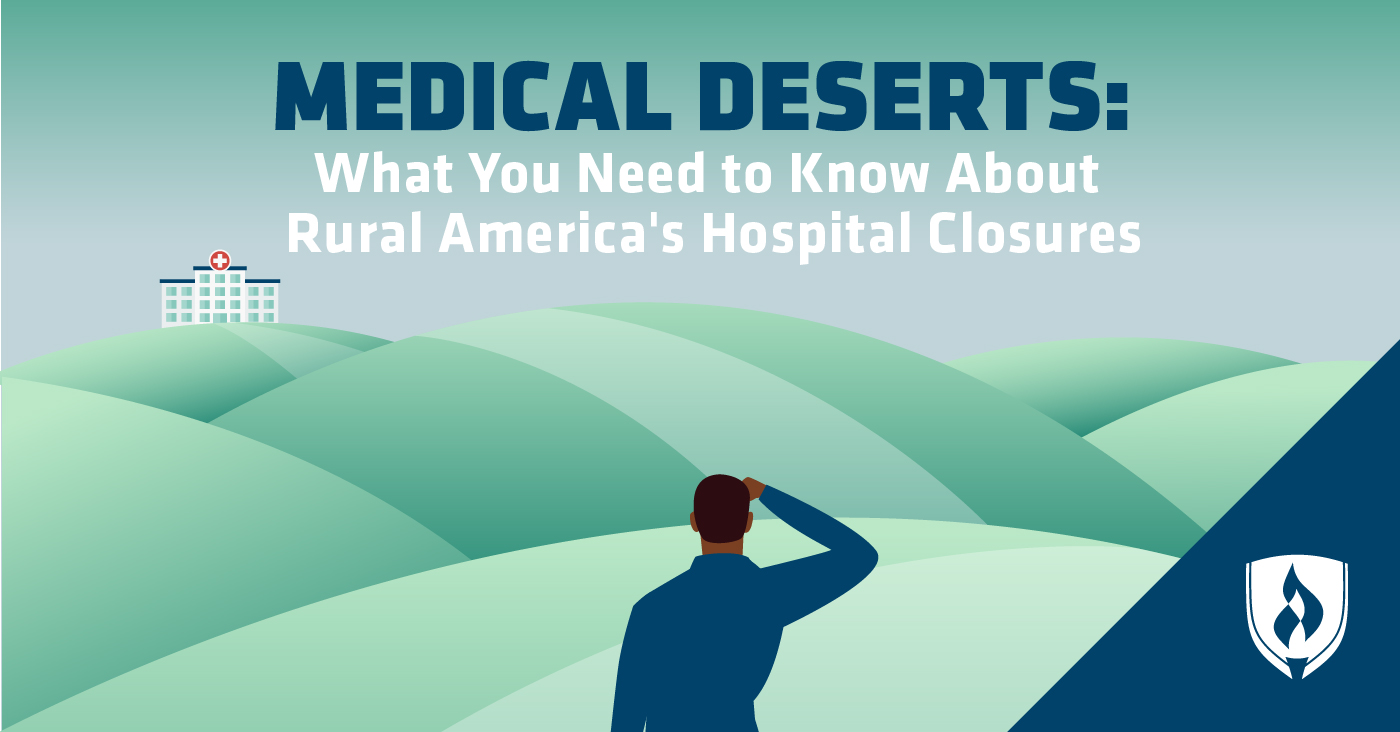Hospital Closures: What You Need to Know About Rural America's Medical Deserts
By Hannah Meinke on 10/28/2019

Healthcare in America is obviously a pretty contentious topic. Debates rage on about how to make effective healthcare treatments more affordable for more people all of the time—but typically these debates don’t focus much on access to care. We tend to assume that if something goes wrong, a team of professionals in a well-equipped facility is nearby and ready to help.
But imagine if you were in a bad car accident on the interstate or had a heart attack in your living room, and the nearest hospital was 70 miles away. Every second counts in these situations—and for hundreds of rural towns across America, that terrifying thought has become a reality.
Hospitals in rural areas have recently fallen on hard times and are closing—leaving what many are calling “medical deserts” in their wake. In this article we’ll explore why medical deserts have become more common, the potential consequences and what’s being done or proposed to ease these issues.
What is a medical desert?
According to the University of North Carolina’s NC Rural Health Research Program, 118 rural hospitals have closed since 2010.1 As a result, millions of Americans are more than an hour away from the closest trauma care center. When it comes to emergency care, the term “medical desert” is not just an illustration of distance but one that carries lethal weight. Couple that with the fact that many of the rural healthcare facilities that are still available may not have as broad of an array of specialized care units (and the corresponding staff and facilities for them) and it’s easy to see how many rural communities are in a precarious position.
When a rural hospital closes, hundreds of people are left with no reliable way to get the care they need. Often, they do not have the financial means to uproot their lives and move closer to the next nearest hospital. On top of that, many rural families have lived in the same area on land their families have owned for generations, making a move seem all the more impossible.
What are the consequences of rural hospital closures?
A report from the Center for Disease Control and Prevention (CDC) shows that people in rural America are 50 percent more likely to die from accidental causes due in large part to their distance from trauma centers.2
Some may try to dismiss hospital closures as another bureaucratic problem, but story after story of death from distance gives a grim face to this issue. It leaves many wondering if their loved ones would have survived if things were different. In short, this is not just a matter of increased risk or inconvenience. It is—and has been—a matter of life and death.
Another study by the National Center for Biotechnology Information found that per capita income falls 4 percent and the unemployment rate rises 1.6 percent when a rural hospital closes.3 These facilities often employ over 100 people, and when they close that means there are over 100 people who are laid off with no other healthcare facility to hire them—and over 100 people whose spending power is drained from local economies.
As you might imagine, many are concerned that the health risks and job loss from hospital closures will affect the future of their small town. After all, without a hospital, it stands to reason that people and businesses are less likely to move there and many may choose to leave if feasible. Between this and job loss, hospital closures are not just taking a toll on the health of rural towns, but are perpetuating their already delicate economic systems.
Why are rural hospitals closing?
It’s only natural to wonder what exactly has spurred these closures—and as much as we might like simple black and white answers, the truth is it’s a pretty complex set of cascading issues leading to hospital insolvency. One major factor is that the “Great Recession” put a lot of economic strain on rural communities and many still haven’t fully recovered as residents pack up in search of stronger employment prospects.
In good times it’s hard enough to run a hospital with the small population of a rural community limiting both its staff and its pool of patients, but when a sizable portion of that population cannot pay full price for their services, it becomes nearly impossible.
Rural workers tend to have more contract jobs that don’t offer insurance and many may not be able to afford quality private insurance on their own. This plus an overall aging population means that many residents depend on Medicare or Medicaid—and with Medicaid, many states with heavily rural populations have refused to expand it under the Affordable Care Act. Though these public programs were designed to make healthcare more affordable to low-income demographics, they pay hospitals much less than private insurance—sometimes as much as 50 percent less. Hospitals are left to absorb the cost difference and suffer the damage. Taken all together, you’ve got a recipe for very challenging financial times for hospital administrators.
What is being done to address this?
While the statistics may be scary, it is important to remember that not all rural hospitals are headed towards the same fate. While it’s likely larger-scale policy changes will need to be made to address this issue, some providers are adapting and attempting to forge a new path forward. One such hospital in Arizona is focusing on three key areas to stay viable and serve the needs of its population.
Focusing on emergency and outpatient care
One of the most difficult things about hospital closures is the “all or nothing” feeling that comes with them. When limited money is being spent on maintaining inpatient services that aren’t as pressing as emergency care, it can be frustrating at best. One of the ways hospitals can reduce their costs is by converting to stand-alone emergency and outpatient centers. Not only is this much less expensive than running a full-scale hospital, but it also better serves the immediate needs of rural citizens.
Investing in telehealth for specialty services
If rural hospitals begin to convert to emergency centers, the long-term needs of their patients will still need to be considered. People in rural areas are at higher risk for issues that require specialty care such as heart disease, cancer, chronic respiratory disease, and stroke, according to the Rural Health Information Hub. While someone in need of specialty care could drive to the next nearest hospital, it is still an immense burden to take time off from work, arrange transportation, childcare and travel costs.
Through telehealth technology, specialist doctors can consult through audio and video channels with a rural outpatient center, and can even respond to real-time data. This option is much more affordable for both patients and hospitals, further reducing costs and making rural healthcare more viable.
Expanding mid-level provider scope
One of the biggest expenses of any hospital is its staff, and in order to draw qualified candidates, hospitals cannot compromise on this cost. They can, however, begin to utilize the skills of nurse practitioners (NP) and physician's assistants (PA). Both of these roles are highly educated but often go underutilized due to the presence of a physician or policy that requires a physician’s oversight. By allowing NPs and PAs to diagnose and prescribe as they are allowed in some states, it is argued that hospitals could still provide quality healthcare at a much lower cost.
Ready to tackle this challenge head-on?
As you can see, medical deserts are a serious issue placing huge economic pressure on rural communities that can ill-afford it. Rural healthcare faces considerable challenges that require skilled administrators to navigate them.
1University of North Caroline, Cecil G. Sheps Center for Health Services Research, NC Rural Health Research Program, 155 Rural Hospital Closures: January 2005 – Present, [accessed September 2019] https://www.shepscenter.unc.edu/programs-projects/rural-health/rural-hospital-closures/
2U.S. Department of Health and Human Services, Centers for Disease Control and Prevention, CDC Newsroom, Rural Americans at Higher Risk of Death from Five Leading Causes, [accessed September 2019] https://www.cdc.gov/media/releases/2017/p0112-rural-death-risk.html
3National Center for Biotechnology Information, Health Services Research, The Effect of Rural Hospital Closures on Community Economic Health, [accessed September 2019] https://www.ncbi.nlm.nih.gov/pmc/articles/PMC1702512/




